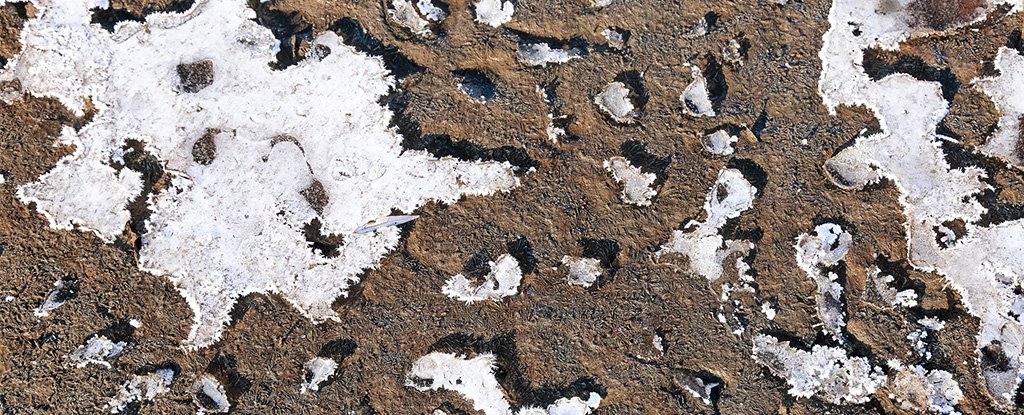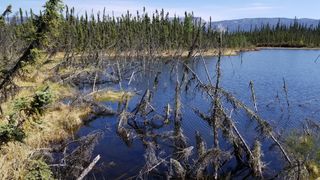UPDATED
Rapid Permafrost Collapse Is Underway,
Rapid Permafrost Collapse Is Underway,
Disintegrating Landscapes And Our Predictions
MARLOWE HOOD, AFP 5 FEB 2020

Permafrost in Canada, Alaska and Siberia is abruptly crumbling in ways that could release large stores of greenhouse gases more quickly than anticipated, researchers have warned.
Scientists have long fretted that climate change - which has heated Arctic and subarctic regions at double the global rate - will release planet-warming CO2 and methane that has remained safely locked inside Earth's frozen landscapes for millennia.
It was assumed this process would be gradual, leaving humanity time to draw down carbon emissions enough to prevent permafrost thaw from tipping into a self-perpetuating vicious circle of ice melt and global warming.
But a study published on Monday in Nature Geoscience says projections of how much carbon would be released by this kind of slow-and-steady thawing overlook a less well-known process whereby certain types of icy terrain disintegrate suddenly - sometimes within days.
"Although abrupt permafrost thawing will occur in less than 20 percent of frozen land, it increases permafrost carbon release projections by about 50 percent," said lead author Merritt Turetsky, head of the Institute of Arctic and Alpine Research in Boulder, Colorado.
"Under all future warming scenarios, abrupt thaw leads to net carbon losses into the atmosphere," she told AFP.
Permafrost contains rocks, soil, sand and pockets of pure ground ice. Its rich carbon content is the remains of life that once flourished in the Arctic, including plants, animals and microbes.
This matter - which never fully decomposed - has been frozen for thousands of years.
It stretches across an area nearly as big as Canada and the United States combined, and holds about 1,500 billion tonnes or carbon - twice as much as in the atmosphere and three times the amount humanity has emitted since the start of industrialisation.
Some of this once rock-solid ground has begun to soften, upending indigenous communities and threatening industrial infrastructure across the sub-Arctic region, especially in Russia.
The evidence is mixed as to whether this not-so-permanent permafrost has started to vent significant quantities of methane or CO2. projections are also uncertain, with some scientists saying future emissions may be at least partially offset by new vegetation, which absorbs and stores CO2.
But there is no doubt, experts say, that permafrost will continue to give way as temperatures climb.
'Fast and dramatic'
In a special report published in September, the UN's scientific advisory body for climate change, the IPCC, looked at two scenarios.
If humanity manages - against all odds - to cap global warming at under 2°C, the cornerstone goal of the 2015 Paris climate treaty, "permafrost area shows a decrease of 24 percent by 2100", it concluded.
At the other extreme, if fossil fuel emissions continue to grow over the next 50 years - arguably an equally unlikely prospect - up to 70 percent of permafrost could disappear, the IPPC said.
But both scenarios assume the loss will be gradual, and that may be a mistake, Turetsky suggested.
"We estimate that abrupt permafrost thawing - in lowland lakes and wetlands, together with that in upland hills - could release 60 to 100 billion tonnes of carbon by 2300," she and colleagues noted in a 2019 comment also published by Nature.
One tonne of carbon is equivalent to 3.67 tonnes of carbon dioxide (CO2), which means this would be equivalent to about eight years of global emissions at current rates.
"This is in addition to the 200 billion tonnes of carbon expected to be released in other regions that will thaw gradually," she said.
Current climate models do not account for the possibility of rapid permafrost collapse and the amount of gases it might release, the study notes.
Abrupt thawing is "fast and dramatic", Merritt said, adding: "Forests can become lakes in the course of a month, landslides can occur with no warning, and invisible methane seep holes can swallow snowmobiles whole."
Some permafrost zones thaw faster than expected and are reshaping the Arctic landscape.
By Mindy Weisberger - Senior Writer

Trees struggle to remain upright in a lake formed by abrupt
By Mindy Weisberger - Senior Writer

Trees struggle to remain upright in a lake formed by abrupt
permafrost thaw. (Image: © David Olefeldt)
Arctic permafrost can thaw so quickly that it triggers landslides, drowns forests and opens gaping sinkholes. This rapid melt, described in a new study, can dramatically reshape the Arctic landscape in just a few months.
Fast-melting permafrost is also more widespread than once thought. About 20% of the Arctic's permafrost — a blend of frozen sand, soil and rocks — also has a high volume of ground ice, making it vulnerable to rapid thawing. When the ice that binds the rocky material melts away, it leaves behind a marshy, eroded land surface known as thermokarst.
Previous climate models overlooked this kind of surface in estimating Arctic permafrost loss, researchers reported. That oversight likely skewed predictions of how much sequestered carbon could be released by melting permafrost, and new estimates suggest that permafrost could pump twice as much carbon into the atmosphere as scientists formerly estimated, the study found.
Frozen water takes up more space than liquid water, so when ice-rich permafrost thaws rapidly — "due to climate change or wildfire or other disturbance" — it transforms a formerly frozen Arctic ecosystem into a flooded, "soupy mess," prone to floods and soil collapse, said lead study author Merritt Turetsky, director of the Institute of Arctic and Alpine Research (INSTAAR) at the University of Colorado Boulder.
"This can happen very quickly, causing relatively dry and solid ecosystems (such as forests) to turn into lakes in the matter of months to years," and the effects can extend into the soil to a depth of several meters, Turetsky told Live Science in an email.
By comparison, "gradual thaw slowly affects soil by centimeters over decades," Turetsky said.
Arctic permafrost can thaw so quickly that it triggers landslides, drowns forests and opens gaping sinkholes. This rapid melt, described in a new study, can dramatically reshape the Arctic landscape in just a few months.
Fast-melting permafrost is also more widespread than once thought. About 20% of the Arctic's permafrost — a blend of frozen sand, soil and rocks — also has a high volume of ground ice, making it vulnerable to rapid thawing. When the ice that binds the rocky material melts away, it leaves behind a marshy, eroded land surface known as thermokarst.
Previous climate models overlooked this kind of surface in estimating Arctic permafrost loss, researchers reported. That oversight likely skewed predictions of how much sequestered carbon could be released by melting permafrost, and new estimates suggest that permafrost could pump twice as much carbon into the atmosphere as scientists formerly estimated, the study found.
Frozen water takes up more space than liquid water, so when ice-rich permafrost thaws rapidly — "due to climate change or wildfire or other disturbance" — it transforms a formerly frozen Arctic ecosystem into a flooded, "soupy mess," prone to floods and soil collapse, said lead study author Merritt Turetsky, director of the Institute of Arctic and Alpine Research (INSTAAR) at the University of Colorado Boulder.
"This can happen very quickly, causing relatively dry and solid ecosystems (such as forests) to turn into lakes in the matter of months to years," and the effects can extend into the soil to a depth of several meters, Turetsky told Live Science in an email.
By comparison, "gradual thaw slowly affects soil by centimeters over decades," Turetsky said.
Creating feedback
Across the Arctic, long-frozen permafrost is melting as climate change drives global temperatures higher. Permafrost represents about 15% of Earth's soil, but it holds about 60% of the planet's soil-stored carbon: approximately 1.5 trillion tons (1.4 trillion metric tons) of carbon, according to the National Snow and Ice Data Center.
When permafrost thaws, it releases stored carbon into the atmosphere. This release can then speed up global warming; this cycle is known as climate feedback, the scientists wrote in the study.
Aerial image of a permafrost peatland in Alaska's Innoko National Wildlife Refuge, interspersed with smaller areas of thermokarst wetlands. (Image credit: Miriam Jones, U.S. Geological Survey)
In fact, carbon emissions from about 965,000 square miles (2.5 million square kilometers) of quick-thawed thermokarst could provide climate feedback similar to emissions produced by nearly 7 million square miles (18 million square km) of permafrost that thawed gradually, the researchers reported.
And yet, rapid thawing from permafrost is "not represented in any existing global model," study co-author David Lawrence, a senior scientist with the National Center for Atmospheric Research, said in a statement.
Abrupt permafrost thaw was likely excluded from prior emissions models because it represents such a small percentage of the Arctic's land surface, Turetsky explained.
"Our study proves that models need to account for both types of permafrost thaw — both slow and steady change as well as abrupt thermokarst — if the goal is to quantify climate feedbacks in the Arctic," Turetsky added.
The findings were published online Feb. 3 in the journal Nature Geoscience.
Images of melt: Earth's vanishing ice
Originally published on Live Science.
No comments:
Post a Comment